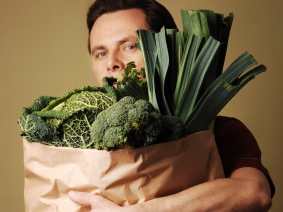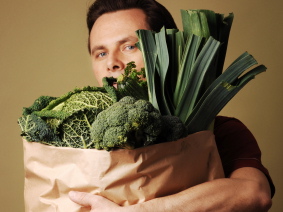
bag, l
(article, Mary Roach)
Dinnertime, on the road from New Hampshire to New York, my big brother Rip and me. Old Clam Box, Next Exit, says the billboard. “I hate clams,” says my brother. “Look, there’s a Burger King.” Rip orders a Whopper, his way. “No tomatoes, no pickles, no onions. Hold the mayo and mustard. Easy on the ketchup.” I don’t know this guy. I want to crawl under the condiment bar. “Why don’t you order a regular burger and give the poor woman a break?” “I don’t like their regular hamburgers,” says Rip. “The buns have funny little seeds. Besides, special orders don’t upset them.” They upset me. Back in the car, I continue my tirade. “What’s wrong with you? You don’t like anything!” From Bellows Falls to Brattleboro, I reel off the most delectable foods I can think of, while Rip sits in the driver’s seat making yucky faces. [%image "yuck" float=right width=350 credit="Photo: iStockphoto/Glassbottle" caption="You say tomato, she says yuck."] “Mushrooms? Asparagus? Veal parmigiana?” “Nope.” “Dates? Salmon? Lamb?” “Blechh.” “Bing cherries, for God’s sake.” “Maraschino. Maybe. If it’s in an old-fashioned.” “You’re weird.” “No, you’re weird.” It’s his turn now. “You eat stinky cheese and raw quail eggs. I saw you eat dry cat food in third grade. You’re a scavenger, an indiscriminate glutton.” And so it goes. He says potato, and I say polenta. I say tomato, he says disgusting. Somewhere around the Vermont border, we called the whole thing off. But I was determined to get to the bottom of this. How was it possible for two people raised by the same parents, under the same roof, down the hall from the same refrigerator, to prefer such radically different foods? Is there really no accounting for taste? My quest begins at the Monell Chemical Senses Center, a private research lab on the outskirts of the University of Pennsylvania campus. (You can’t miss it — it’s the one with the 12-foot brass sculpture of a human nose and mouth out front.) I talk to Gary Beauchamp, the assistant director. Beauchamp can’t tell me why my brother and I ended up with such different appetites, but he assures me we didn’t start out that way. All human beings, even my brother Rip, are born with the same basic taste preferences. We like sweet things, and we don’t like anything bitter or sour. Since infants can’t be relied upon to fill out questionnaires, researchers can gauge their preferences with something called the gusto-facial reflex. In one study, sweet substances elicited sucking and little smiles. Sour tastes produced “lip pursing and wrinkling of the nose,” and bitter prompted “opening of the mouth with the upper lip elevated and protrusion of the tongue” — the classic yucky face. Those reactions make evolutionary sense: Toxic plants are often bitter or sour, Beauchamp says, while sweeter vegetables tend to be more nutritious and less likely to be poisonous than bitter vegetables. Mothers’ milk is sweet. So are ripe fruits — all good sources of vitamins, minerals, and calories. But wait a minute: If it’s calories and nutrients our bodies are after, wouldn’t it be more logical for us to prefer the taste of fats and vitamins? “Vitamin needs get piggybacked onto sweet fruits and vegetables,” says Beauchamp. As for fats: “The chemical structure of a fat is much more complicated than that of a simple molecule like sugar,” he says. Human taste receptors — the little red dots clustered into “buds” on the sides and tip of your tongue — are built to recognize sweet, salty, bitter, sour, and perhaps one or two other compounds. “Designing receptors to fit the various fat molecules would be more difficult.” Okay, I’m satisfied. But how do these molecular goings-on translate into love and loathing? “Different types of taste receptors project to different areas of the brain,” says psychologist Linda Bartoshuk of the Yale University School of Medicine. “It’s as though the brain is looking at this massive wiring diagram and saying, ‘Aha, that spot lit up, so that’s a sweet taste.’” But why, I persist, does an ordinary, unassuming tollhouse cookie register as unmitigated bliss when it hits the tongue? Bartoshuk sighs. “What makes humans experience sweet the way they do is a philosophical question.” I sigh. Elliott Blass, a psychologist at Johns Hopkins University, has another idea: When the tongue’s sweet taste receptors relay their message to the brain, he believes, it triggers a release of endorphins, the body’s own opiates. Blass says sucrose affects infant rats much like morphine does: It makes them stop crying. (Yes, even rats cry. But you need ultrasonic equipment to hear them.) It’s a phenomenon known to mothers and nannies the world over: A teaspoon of sugar water will often quiet a howling infant. It also fits with another commonly observed phenomenon — the intense sugar cravings of heroin addicts. Does that mean that people become addicted to sugar the way they become addicted to narcotics? Nobody knows. If sugar really were physically addictive, it would take higher and higher concentrations of sweet substances for the taste to remain a source of pleasure. Which doesn’t seem to happen, or nouvelle desserts like lemon mousse wouldn’t stand a chance against Twinkies. Perhaps Rip has something wrong with his taste buds. I call Bartoshuk back. There isn’t necessarily anything wrong, she says. Maybe Rip’s just different. Many people — about two-thirds of the U.S. population, in fact — have a genetic sensitivity to certain bitter chemical compounds. This affects their perception of a whole range of foods, from cabbage to cheddar cheese. For reasons unknown, “tasters,” as researchers call them, also tend to be more sensitive to sweets. “It may be that they’re born with taste receptors the rest of us don’t have,” Bartoshuk says. A pair of quick taste tests (see sidebar) confirmed the hypothesis: Rip’s a taster, and I’m not. [[block(sidebar). h1. Are you a taster? Finicky eaters have a scientific excuse: Their palates may actually be more sensitive to the taste of certain foods. Everyone is born with taste receptors for sweet, salty, bitter, and sour. But two-thirds of Americans also have receptors that enable them to taste a bitter chemical called phenyithiocarbamide, or PTC. Foods that contain PTC, or compounds that are chemically similar, taste more bitter to “tasters” than to “non-tasters.” To find out which you are, put a little salt substitute (potassium chloride) on the tip of your tongue. To a non-taster, it’s basically salty; to a taster, it will be about equally bitter and salty. Or try saccharine. Non-tasters will find it a perfect sugar substitute; tasters will pick up a bitter taste. Here’s a list of other foods that tasters may not like: bok choy broccoli Brussels sprouts coffee mustard greens grapefruit radishes sauerkraut strong cheese ]] So the guy’s got an excuse for broccoli and spinach. But what about avocados, roasted chestnuts, baked beans, sashimi? They’re not bitter. No, says Leann Birch, professor of nutritional sciences at the University of Illinois, but they may be new to him. Humans, especially kids, tend to be suspicious of novel things — it’s called neophobia. “As omnivores,” Birch says, “we need variety in our diets, so we have to try new things. On the other hand, if you want to stay alive, you have to be somewhat conservative about what you put into your system.” Homo sapiens today does most of its foraging in supermarkets rather than on the forest floor, but neophobia lingers on. Psychologists Marcia Pelchat and Patricia Pliner devised an experiment to find out for certain whether it’s the novelty of a dish or some other aspect that prompts people to spurn it. They gave two groups of people helpings of identical foods. For the first group, the foods were accurately named — “chopped tomatoes,” “oatmeal,” and “beefsteak” — and subjects were quite willing to taste them. But people led to believe they’d be tasting “pendula fruit,” “lat,” and “langua steaks” (described as the meat of a South American game animal) weren’t nearly as cooperative. (Remember Dr. Seuss? “I would not eat green eggs and ham. I do not like them, Sam-I-am.”) But when it comes to conquering the fear of novel foods, “try it, you’ll like it” works for most of us. “Mere exposure to something — tasting it, in the case of food — tends to make us like something better,” says Birch. “That’s true of foods, faces, smells, music, you name it.” (“Say! I like green eggs and ham! I do! I like them, Sam-I-am!”) That first exposure to a food may come very early in life, says Beauchamp, because tastes and smells can be carried in mother’s milk. Farmers have found that when sows are fed a special diet while nursing, their piglets can be weaned on to the food easily; it’s already familiar. “We have every reason to suspect that a similar thing happens in humans,” Beauchamp says. The effect is particularly noticeable with strongly aromatic foods. “Ethnic preferences for garlic,” he says, “may be established very early.” Animal research also suggests that the more things you taste when you’re young, the more likely you’ll be to experiment with new foods later. Marcia Pelchat says that’s what happens with rats, dogs, cats, and birds fed varied diets shortly after weaning, compared to animals weaned on to restricted diets. What does this have to do with my brother and me? Was my mother restricted to bland foods during her first pregnancy? Did she try out a new Gerber’s flavor on me every week? Not likely, says Birch. In humans, food preferences can be shaped by an endless menu of factors: everything from peer pressure and Saturday morning TV to Mom’s culinary blunders. “With oligophagics — adults who eat only a few foods,” says Birch, “it can sometimes be traced to an unpleasant event surrounding eating as a child. Like being forced to eat things. I mean actually having food shoved into the mouth.” Hello, Mom? Even less extreme tactics — like the “no-dessert-until-you-eat-your-peas” ploy — often backfire, Birch says. Peas become ever more loathsome; dessert, all the more enticing. “The result is quite the opposite of what the parents intended,” says Birch. “When you take away the reward, children are less likely than before to eat the nutritionally desirable food.” So maybe my parents tried too hard with Rip. Then again, maybe they didn’t try hard enough. As Sam-I-am would attest, it’s the first bite that’s the real challenge. But one mouthful of limburger does not a cheese fancier make. “It often takes as many as 10 exposures for a child to get over the fear of a new food,” says Birch. Of course, a lot depends on the food. “Sweetness and blandness generally protect a food from the neophobic response,” says Pelchat. “The more spicy or highly flavored a food, the scarier it is. Think about it. Nobody’s scared of a new dessert.” She’s right. With the possible exception of a large, quivering trifle encountered at a sit-down dinner sometime around 1984, I really can’t recall being unnerved by a dessert. Even Rip is downright brazen when it comes to sampling Sara Lee’s latest. [%image bag float=right size=large credit="Photo: iStockphoto/Silberkorn" caption="Cabbage and broccoli he'll shun, but leeks he might like."] So what prompts a person like me to abandon the sweet and the bland in favor of a more discriminating palate? Why have I gone from Boone’s Farm to chardonnay, from sugar-laden instant to unadorned cappuccino? “The sweetness may actually have helped you acquire a taste for the other flavors,” says Birch. It’s called associative conditioning: Over time, your brain associates a bitter or sour flavor with sweetness. Eventually, you like the new tastes enough to let go of the sugar altogether. Linda Bartoshuk has a simpler answer. “Status. A lot of the pleasure derived from a dry, subtle wine comes from the intellectual games one plays with it,” she says, adding that she herself is partial to sweet German wines. Am I being called a phony? She says not. “I like what I like; you like what you like. To say that liking one thing is aesthetically superior to liking something else is a joke.” Okay, so tuna-noodle casserole tastes no worse than blackened ahi tuna. It just doesn’t sound as impressive. And, I’ll admit, becoming an impressive eater does take special circumstances. It’s hard to sample the latest ethnic cuisine when you live in a town with only three restaurants. But would most Americans actually eat spicier, more exotic foods if they could get them? Supermarkets wouldn’t keep stocking plaster-of-Paris-chicken-with-cornstarch-bearnaise dinners if people didn’t like them, right? Carol Christensen, of Pillsbury’s Sensory Evaluation Section, doesn’t believe that Americans prefer such bland foods. It’s just that when it comes to packaged foods, the neophobic minority calls the shots. "Let's say we’re running a flavor screening for a new line of casseroles. There will always be those who say, 'Ugh, I hate green peppers' or 'Yecch, I can't stand olives.' If you’re trying to cater to the entire population, by the time you’re through you inevitably end up with something bland. It’s kind of like a presidential candidacy. You try to create something inoffensive, but in avoiding all the negatives, you end up without any positives." Of the four basic food groups, Marcia Pelchat says, people are most afraid of meat and fish and, to a lesser extent, vegetables. Although her research subjects were none too thrilled about “lat” and “pendula fruit,” they were even more reluctant to sample “langua steaks.” The ranking seems to hold true even when you can’t see the food. When military menu planners survey troops’ food preferences, the questionnaires often include nonsense foods, which help establish a baseline for analyzing the ratings. “Of our three nonsense foods,” says Herbert Meiselman, head of the U.S. Army, Natick, Behavioral Sciences Division, “funistrada invariably rates the highest. People think it’s some sort of pasta dish.” (Compared with real-life comestibles, it’s about on a par with cooked carrots.) “Buttered ermal, our nonsense vegetable, consistently ranks lower. Braised trake fares worst of all.” And no wonder. “People tend to confuse it with tripe and hake,” he says. Fear of vegetables makes sense, given what I’ve heard about bitter tasters and sour poisons. But why are people so afraid of unfamiliar meats? Meat seems to go beyond suspicion, beyond mere fear. “Meat,” says Pelchat, “is a primary focus of disgust.” And with that she refers me to Paul Rozin. Rozin is a University of Pennsylvania psychologist, known among his colleagues as the King of Disgust. Disgust, Rozin informs me, is a basic human emotion, right up there with anger, fear, and happiness. It’s the emotion most closely linked to food or, more properly, rejecting food. What Rozin refers to as the universal “disgust face” probably evolved as a mechanism for doing just that: Nostrils closed to ward off objectionable smells, mouth open to facilitate a hasty dispatch of the offending item. Anyway, back to meat. Humans have what Rozin calls “meat ambivalence.” We like the taste of meat and we know it’s good nutrition, but on some basic level the thought of consuming another animal’s flesh appalls us. A mild form of the cannibalism taboo, suggests Pelchat. Rather than give up meat, most of us try to disguise it. Pig becomes pork, baby cow becomes veal. We chop meat, filet it, grind it — only rarely do we serve it whole. “Meat is fine as long as it doesn’t look like meat,” as Pelchat says. That’s one reason organ meats are so thoroughly unloved. Even filthy-dirty-Mary-I-eat-anything-Roach (as my boyfriend is wont to call me) draws the line at lamb’s kidneys. Disguised or not, meat is one of the most common food aversions. Aversions are learned associations — Pavlovian conditioning in the everyday world. Eat a food while you’re feeling sick to your stomach and you may come to associate that food with illness, avoiding it ever after. Monell nutritionist Richard Mattes says that people often form aversions to greasy foods and foods high in protein, perhaps because these foods cause the stomach to secrete a lot of gastric acid — as in “acid indigestion.” Fats add to the problem, because they relax the sphincter muscle of the esophagus, allowing acid to seep out of the stomach and bring on the familiar sear of heartburn. “Meat has both protein and fat,” says Mattes, “so it’s a double whammy.” [%image fridge float=left width=350 caption="A whole fridge and nothing to eat." credit="Photo: iStockphoto/caracterdesign"] An aversion to a food can develop even if the food itself obviously isn’t the cause of the nausea. Say you eat a breakfast of soft-boiled eggs just before a deep-sea fishing trip, during which you become violently seasick. You know breakfast wasn’t to blame. But like a stubborn grandmother, your subconscious insists that if your stomach hurts, it must’ve been something you ate. So now I’ve got another theory: Rip was simply a dyspeptic toddler, who developed aversions to everything he ate. Rozin is skeptical. While 38 percent of the people in one survey said they’d had a food aversion at some time in their life, few people ever have more than a couple. Then what is it about my brother? I begin reeling off some of the wonderful things he refuses to eat. Oysters, persimmons, okra . . . “Many people find slimy foods upsetting,” says Rozin, “or anything with a mucoid texture.” This is an example of what he calls “secondary disgust” — disgust for something that looks or feels similar to something disgusting in its own right. Rozin cites one of his experiments, in which subjects were presented with two pieces of chocolate fudge, one shaped to look like a muffin, the other sculpted into a convincing replica of a mound of dog droppings. Guess which one they wouldn’t go near. Try that in any culture and you’d get the same response. But in general, where you grow up will determine what’s disgusting and what’s delightful. “There are plenty of foods considered delicacies in other cultures that you wouldn’t eat,” says Rozin. Oh, yeah? Me? He begins listing examples. Giant water bugs in China. Fried cockroach eggs in Laos. Dog meat, rat stew, grasshoppers, grubs. Sheep’s head, bull’s . . . Okay, okay, point taken. By international standards, I’m a food wimp. Everything is relative — including your relatives’ taste in food. I’ve gone from biochemistry to psychology to anthropology, and I still don’t know just what it is that makes my brother order a hamburger at a four-star seafood restaurant. Hardly surprising, I suppose. The study of human behavior is an inexact science, as its researchers are quick to admit. “There are a zillion factors that shape an adult’s food habits,” says Pelchat. Even if I knew all zillion of them, I have a feeling I still wouldn’t be able to get Rip to give up his cornflakes and macaroni-and-cheese dinners. As they say, one man’s ambrosia is another man’s braised trake. p(bio). A contributing editor at Discover magazine, Mary Roach is the author of the bestselling books [%amazonProductLink Stiff asin=0393050939] and [%amazonProductLink Spook asin=0393329127]. This article originally appeared in Hippocrates (now Health_) magazine. *Also on Culinate: An article about our reactions to cilantro.

bag, l

fridge, l

promo-image, l

feature-image, l

yuck, l

reference-image, l